Sights of Tata
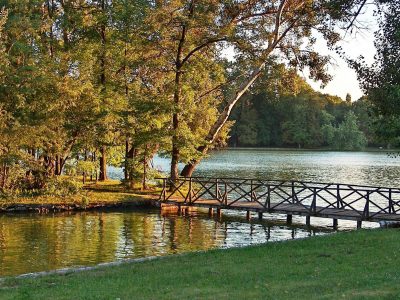
1. Fishing opportunities at Cseke Lake
With 23 hectares of surface area and two small islands, Cseke Lake is a popular destination for fishing enthusiasts. Those who wish to participate in this hobby can purchase daytime, nighttime or children’s ticket as well. Daytime ticket users can fish from 5 am until sundown. Night tickets are available from May 1st until September 30th, on Fridays and Saturdays, from 7 pm until 7 am, excluding holidays. Tickets are available at the fishing house in Cseke-liget (at the lakeside) or in the fishing shop on Ady Endre street. The lake offers a wide variety of fish, including carp, catfish, perch, pike, trout, tench, crucian, and different types of bream.
Cseke-Lake Photo: Tourinform Iroda, Tata ©
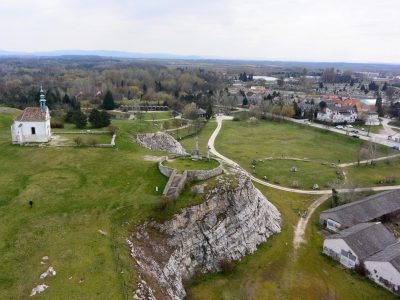
2. Kálvária Hill
Located at the southwest part of the town, Kálvária Hill is a prime destination for hikers. On top of the hill you can marvel at the chapel with its baroque style frescos, or visit the remains of the Kálvária statues next to it. For those interested in science, at the foot of the hill you can find an open air geological and paleontological museum. In case you are not satisfied with the beautiful panorama the hill provides, you can climb the forty meter high lookout tower, from where you can take in the entire town, as well as the surrounding mountains. The hill is just a ten minute walk away from the Esterházy Castle, straight along Fazekas street.
Kálvária-domb a Fellner Jakab-kilátóból nézve Fotó: funiQ
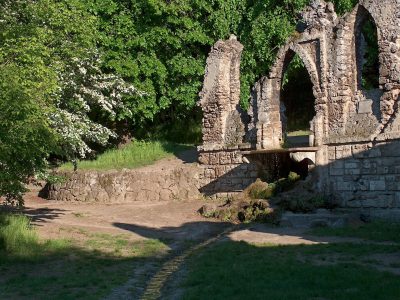
3. English Park
On the shores of the Cseke Fishing Lake you can find the English Gardens, built by the Esterházy family, which in fact is the first public garden in Hungary built in this style. The park is admission free, and offers a wide variety of sights to behold. Walking on the Northern shore of the lake will present you with the romantic style artificial ruins, designed by Charles Moreau, built from the stones of the remains of the Vértesszentkereszt Abbey. In a short distance you will find a Turkish mosque. Further inside the park is an open air theatre. The Esterházy family makes its presence known by some of their private establishments, including their Summer Castle, the Sparkling Wine Factory and the Palm House, the latter of which is used as an event hall these days. On the border of the gardens you can find the olympic training center, which is actively used to this day.
Műromok az Angolkertben Fotó: Tourinform Iroda, Tata ©

4. Fényes Educational Trail
One of the most magical sights in all of Tata, the Fényes Educational Trail is a 1,350 meter long wooden walkway above the clear spring waters, among the alder trees of the marsh forests. This ecotouristical trail interactively exhibits the local flora and fauna over 18 stations. You don’t have to look far to see tortoises and beavers in their natural habitats, or marvel at the beauty of water lilies and other marsh plants. From the lookout tower you can take in the astounding view of the forest quite literally standing in the water. A big favorite of visiting children, you can try the boat where you have to pull yourself to the other side of the lake by hand, or walk across the suspension bridge. The trail is accessible throughout the year, and we warmly recommend it to nature lovers of all ages.
Fényes Tanösvény (Fotó: Bella László)
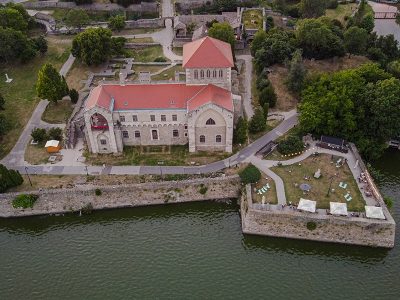
5. Tata Castle
The imposing castle at the tip of the Old Lake is the true symbol of the town of Tata. While the building was originally built as the center of the estate, its history became as colorful as the town itself. If the old grey walls could talk, it would tell us stories of great kings Zsigmond and Matthias Corvinus, of being overtaken by Turks and Habsburgs, of the Esterházy family eventually purchasing it, and of several partial destructions and renovations throughout the centuries. As a matter of fact, the Old Lake itself is only there because they created it when the castle was built. While the original castle had four corner towers, today only the Eastern tower stands. The remaining walls, ruins and the dike are free to access to everyone passing by. Inside the castle is the Kuny Domonkos Museum, where you can look at stone carvings from the Roman and Middle Ages, famous local ceramics, and even the knight’s hall of the castle.
Photo: Erika Gáncs, photojournalist
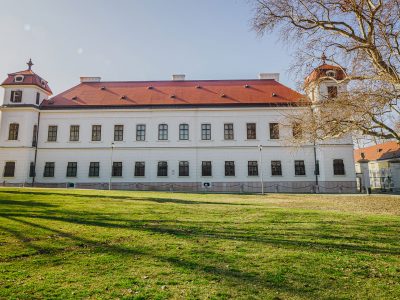
6. Esterházy Castle
The 18th century brought about a turning point in the history of Tata with the arrival of the Esterházy family. This was the time when count Miklós Esterházy, captain of the Hungarian national guard, took ownership of the estate of Tata, and with the help of architect Jakab Fellner, he built his new home here. The splendid castle had two floors – the count lived on the first floor, while his wife the countess lived on the second floor. In the residence of the countess there are rooms that are preserved almost perfectly to this day: the dining hall with its gold-coated wooden panelling, and the bathroom made of marble and Dutch ceramic tiles. The castle, however, is not the only building in the estate. The Esterházy family owned the horse riding school nearby, the Tata Castle itself, and the Summer Castle found in the English Gardens. Today Esterházy Castle operates an exhibition and a café.
Photo: Erika Gáncs, photojournalist
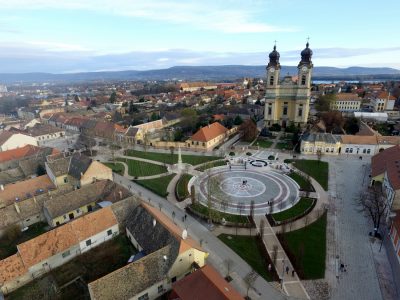
7. Kossuth Square
The town was originally a union between the towns of Tata and Tóváros. The old town of Tata was greatly influenced by the Esterházy family, who purchased it in 1727. The center of the Southern part of this town is Kossuth Square. Ferenc Esterházy commissioned architect Anton Pilgram to build the Szent Kereszt (meaning Saint Cross) Parish Temple, which is the most important building there. The square was originally used as a market. It was renovated into a park in 1964, when they placed a fountain there with a limestone statue in the middle, called Girl Looking into the Water, sculpted by Ferenc Brém. The square was renovated again in 2015 in the name of preserving the historical values of the town. Also on the square you can find the Fischer House, a baroque building from the late 18th century, birth place of Mór Farkasházy Fischer, founder of the famous porcelain factory in Herend.
Photo: www.pentakft.hu: Tata Kossuth-tér
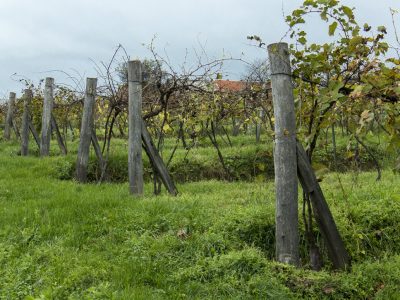
8. Wine Cellars of Baj
Historically a part of Tata, the village of Baj also used to belong to the Esterházy family. After they built their sparkling wine factory, they needed a source of quality wine as ingredient, which they acquired from the vineyards of Baj. The family built a great wine cellar there with a unique, star shape with fourteen branches, which is one of the major sights of the village to this day. The vineyards of Baj celebrated their golden age at the turn of the 20th century, when visitors of the capital came here on cheap train rides, either to see the horse races in Tata, or taste the outstanding wine of Baj. Today the vineyards are a part of the Neszmély Wine Region, and incorporate several brands, some examples being the wines of Turay, Wéber, Hauzer, Jónás, Csaszkóczy and Borboléta cellars.
Wine Cellars of Baj (Photo: Bor.menu)
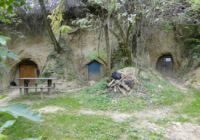
9. Wine Cellars of Dunaszentmiklós
On the Northwestern part of Gerecse, hidden between the mountains, lies the quaint village of Dunaszentmiklós. It is the smallest village in the entire county, with a population of merely five hundred. It got its name from the temple built in the honor of Saint Miklós, and in 1913 they attached the Duna (Danube) prefix to it. The area was already inhabited in the earlier stages of civilisation, evidenced by the archeological artefacts found there. Like many unfortunate villages at the time, Dunaszentmiklós was also destroyed by the Turkish invaders. Two hundred years later, in 1733 József Esterházy helped repopulate the area by having catholic German families move here, most of whom were farmers and wine makers. Thanks to them, the village became famous for its great quality wine, and the „hole cellars” carved close to each other into the loess walls. These cellars are up to fifteen meters long, two meters wide and hardly as tall as a standing man. Although the majority of the German population was forced to move out after the Second World War, most of them returned later. To this day, it is a cohesive community who are proud of their traditions.
Photo: www.utazzitthon.hu
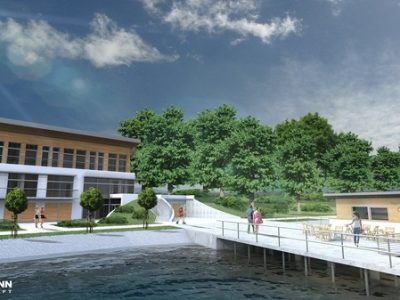
10. For the lovers of active tourism: water sports at the Ecotouristic Center
If you are a real enthusiast of spending your leisure time actively, you need to take no more than a short walk around the Eastern shore of Old Lake, to arrive at the New Kayak House Ecotouristical Center. The Center provides you with sporting opportunities on both water and dry land: cycling, kayaking, and they even offer packages for excursions of 1-3 days, for both individuals and families. Further from the Center, on the other side of the town is the Old Lake Golf Center, which offers an adventure park for both children and adults. The smaller ones can enjoy two courses, while there is a more advanced one for the grown ups. Certified animators are present at all times to ensure the safety of everyone.
Photo: www.hartmannepitesz.hu

